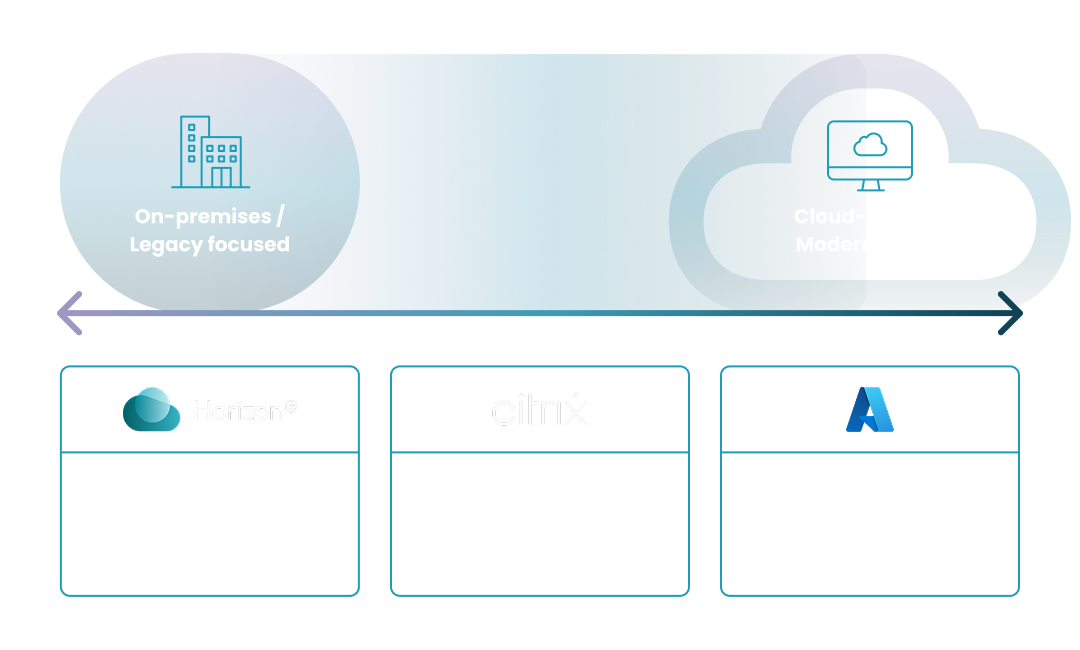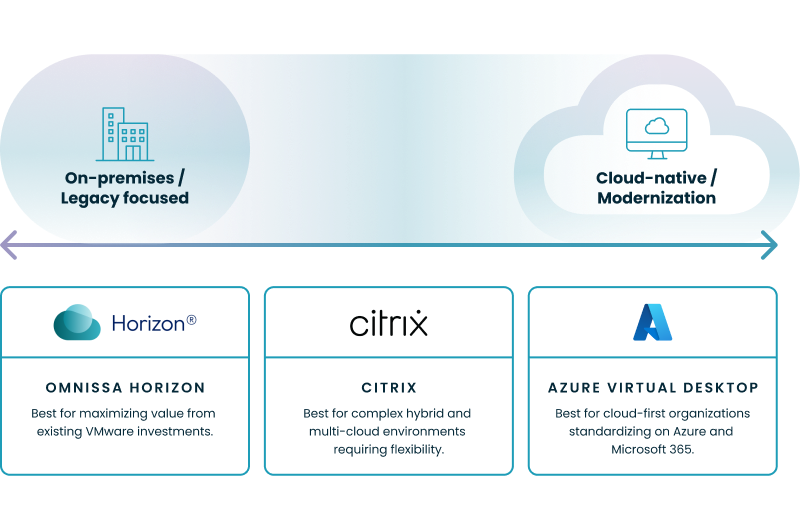Citrix vs VMware vs Azure Virtual Desktop
Choose based on your IT strategy: Citrix as an overlay for complex hybrid IT, Omnissa for on-prem VMware integration, or AVD for cloud-native Azure.
NerdioCon 2026: Don’t miss out! Lock in your spot early and save — this is the IT event of the year.
Register Now
Choose based on your IT strategy: Citrix as an overlay for complex hybrid IT, Omnissa for on-prem VMware integration, or AVD for cloud-native Azure.
Carisa Stringer | October 1, 2025
When evaluating virtual desktop infrastructure, you're comparing established, mature leaders with a modern, cloud-native platform. Citrix DaaS and Omnissa Horizon (formerly VMware's EUC division) have long powered VDI from the corporate data center, while Microsoft's Azure Virtual Desktop (AVD) was designed specifically for the era of cloud computing.
This comparison is no longer just about features but about architectural philosophy—contrasting traditional, component-based infrastructure with an integrated, platform-based cloud service.
Disclaimer: Content referencing Citrix, Omnissa, and Microsoft products is based on public information from those company’s websites, current as of the last article update. Given the rapid pace of software updates (e.g., the Citrix Virtual Apps and Desktops 2507 LTSR) and recent industry consolidation, readers should always verify current features and version details directly with each vendor. For the latest product details and further inquiries, please consult the official company websites.
Understanding the core architecture of each platform is crucial because it directly impacts your team's management overhead and the solution's overall flexibility. The fundamental difference comes down to who manages the complex underlying infrastructure: your IT team or the cloud provider.
| Citrix Virtual Apps and Desktops | Omnissa Horizon (formerly VMware) | Azure Virtual Desktop (AVD) | |
|---|---|---|---|
| Control Plane Management | Customer-Managed: IT team is responsible for deploying, configuring, and maintaining all back-end components. | Customer-Managed: IT team is responsible for deploying and maintaining the Horizon infrastructure components. | Microsoft-Managed: The entire control plane (broker, gateway, etc.) is delivered as a Platform-as-a-Service (PaaS). |
| Primary Environment | Hybrid/Multi-Cloud: Designed to run on-premises in a data center or on any major public cloud (IaaS). | On-Premises / Hybrid: Primarily designed for on-premises vSphere environments, with options for cloud deployment. | Azure Cloud-Native: Runs exclusively in Microsoft Azure, with no on-premises component. |
| Core Components | Component-Based: Requires multiple server roles like Delivery Controllers, StoreFront, and Gateway. | Component-Based: Requires servers for Connection Server, Unified Access Gateway, and integration with vCenter. | Integrated Service: Delivered as a single service; the customer manages session hosts, images, and applications. |
(Note that architectural details may vary by version and deployment model.)
Citrix Virtual Apps and Desktops (CVAD) is a comprehensive solution built from multiple, distinct components that your IT team must install, configure, and maintain. To simplify this complexity, Citrix Cloud offers a SaaS-based management plane, allowing IT to manage both on-premises and cloud-based deployments from a single, unified console.
The front-end user experience is delivered through Citrix Workspace, a unified digital interface that provides access to all the virtual apps and desktops managed by the back-end components. This architecture requires you to manage a dedicated control plane, whether it's in your on-premises data center or on IaaS in the cloud.
Omnissa Horizon is a platform deeply integrated with the broader VMware ecosystem, particularly the vSphere hypervisor. This model relies on a single-vendor stack of components that your team is responsible for deploying and maintaining, making it a natural fit for organizations already invested in VMware infrastructure. However, the Horizon Cloud offering extends this capability, enabling deployment on multiple public cloud platforms, including AWS and Azure, to support hybrid and multi-cloud strategies.
Azure Virtual Desktop (AVD) operates on a completely different model as a Platform-as-a-Service (PaaS) offering. Microsoft manages the entire control plane—including the broker, gateway, and licensing—as part of your Azure subscription, freeing your IT team from the constant maintenance of VDI infrastructure.
Choosing the right platform involves understanding the trade-offs between the granular control of traditional solutions and the streamlined integration of a modern cloud service. This comparison breaks down the key differences in platform support, user experience, and security models.
| Citrix Virtual Apps and Desktops | Omnissa Horizon (formerly VMware) | Azure Virtual Desktop (AVD) | |
|---|---|---|---|
| Platform | Hypervisor-Agnostic: Offers maximum flexibility to run on diverse on-premises hypervisors (vSphere, Hyper-V, etc.) and in multi-cloud IaaS environments. | VMware-Optimized: Primarily designed for and tightly integrated with the on-premises vSphere ecosystem, with cloud deployment options. | Azure Cloud-Native: Exclusively a Platform-as-a-Service (PaaS) offering that runs only in Microsoft Azure, eliminating hypervisor management. |
| Protocol | HDX Protocol: A mature and highly refined protocol renowned for its strong performance over challenging, low-bandwidth, and high-latency networks. | Blast Extreme: A high-performance protocol optimized for high-fidelity graphics and a seamless experience on stable, high-bandwidth corporate networks. It is the sole protocol for modern Horizon deployments. | Modern RDP: A modernized protocol that leverages the Azure global network for an optimized experience and features deep, native integration with Microsoft 365 services. |
| Security Model | Component-Based Security: Relies on add-on components like Citrix Gateway to establish secure remote access, with granular policy controls managed by IT. | Ecosystem-Integrated Security: Secures access via components like Unified Access Gateway and can integrate with VMware NSX for network micro-segmentation. | Native Zero Trust Security: Employs a modern security model by default, integrating directly with Microsoft Entra ID Conditional Access, MFA, and the entire Azure security stack. |
| Management Style | Granular Infrastructure Control: Requires specialized IT expertise to install, manage, and maintain the multiple back-end server components that form the control plane. | Centralized Ecosystem Management: Managed through the Horizon Console and vCenter, requiring deep knowledge of the specific VMware infrastructure stack. | Simplified Service Management: Microsoft manages the entire back-end, allowing IT to focus on user-facing elements like images, applications, and profiles, often via simplified tools like Nerdio. |
The best choice for your organization depends entirely on your business goals and where you are on your IT modernization journey. This spectrum illustrates how each platform aligns with different strategic priorities, from maximizing on-premises investments to embracing a cloud-native future:

These platforms excel when your strategy is centered on your existing data center. Consider them if you need to:
AVD is designed for organizations that are strategically aligning with the cloud. It's the ideal choice when your goals are to:
This step-by-step wizard tool gives you the total cost of ownership for AVD in your organization.
Adopting a modern VDI platform like AVD is a strategic move to reduce infrastructure debt and increase agility. However, managing any large-scale virtual desktop environment in the cloud comes with its own set of operational challenges.
While AVD and Windows 365 remove the need to manage the control plane, enterprise IT teams are still responsible for key operational tasks. At scale, challenges around image management, application deployment, host pool automation, and especially cost control can become significant hurdles. Without the right tools, the promised efficiency of the cloud can be difficult to achieve.
Nerdio provides the tools to bridge the gap between traditional VDI management and modern cloud-native desktops, making the transition seamless and cost-effective.
See this demo to learn how you can optimize processes, improve security, increase reliability, and save up to 70% on Microsoft Azure costs.
See how you can optimize processes, improve security, increase reliability, and save up to 70% on Microsoft Azure costs.
There’s no simple answer, as pricing for all three platforms varies significantly based on multiple factors. Key variables include:
Licensing Models: (e.g., per user, per device, concurrent users, subscription vs. perpetual).
Deployment Size: The number of users and virtual machines directly impacts cost.
Usage Patterns: Consumption-based cloud costs for AVD can fluctuate with usage, while on-premises solutions have higher upfront capital costs. Similarly, when deploying Citrix services on a public cloud, managing the underlying infrastructure is critical, and organizations must have a strategy for how to reduce Citrix DaaS costs on Azure to avoid unpredictable expenses.
Required Features: Advanced editions with more features cost more.
It is highly recommended to use the official pricing calculators and consult with sales representatives for an accurate quote. Beyond direct licensing, a complete financial comparison requires a detailed analysis of the total cost of ownership for Citrix DaaS, which must include indirect costs like Azure infrastructure, IT management overhead, and third-party tool integrations.
Neither platform is universally "better"; the best choice depends entirely on your existing infrastructure and specific needs. Omnissa Horizon (formerly VMware) is often the preferred solution for businesses already heavily invested in the VMware vSphere ecosystem due to its seamless integration. Citrix Virtual Apps and Desktops, on the other hand, is renowned for its flexibility across different hypervisors and its superior user experience on low-bandwidth or high-latency networks. While both are powerful, many organizations now see cloud-native platforms like Azure Virtual Desktop (AVD) as the more modern choice, as they shift management from on-premises infrastructure to a consumption-based cloud service.
The primary disadvantage of Azure Virtual Desktop (AVD) is that it's exclusive to the Microsoft Azure cloud, which can result in vendor lock-in. While Microsoft manages the underlying infrastructure, optimizing costs and managing desktop images and applications at enterprise scale can become complex without specialized third-party management tools.
A "virtual desktop" is the general technology that allows users to access a desktop operating system running remotely on a server. Citrix is a company and a specific product suite (Citrix Virtual Apps and Desktops) that is one of the leading providers of this virtual desktop technology. In short, a virtual desktop is the "what," and Citrix is a "who" that provides it.
AVD is often a better choice for cloud-first organizations deeply integrated with the Microsoft 365 ecosystem, as it offers a more streamlined management model and potential cost savings through its multi-session Windows 10/11 capabilities. However, Citrix remains superior for enterprises that require the flexibility to manage complex workloads across hybrid or multi-cloud environments. As organizations re-evaluate their IT strategies due to factors like licensing changes and a desire for cloud-native integration, many are actively exploring modern Citrix alternatives to reduce legacy infrastructure costs and simplify management.
Hosted VDI, often called Desktop as a Service (DaaS), is generally good for business because it converts large capital expenditures on hardware into predictable operational expenses. This model enhances scalability, supports remote work, and reduces the burden of managing physical infrastructure. The potential downsides are a reliance on the cloud provider and the need to diligently manage cloud consumption to control costs.
You choose between Azure Virtual Desktop (AVD) and Citrix Virtual Apps and Desktops (CVAD) based on your core IT strategy. If your organization is pursuing a cloud-native approach centered on Azure and Microsoft 365, AVD is the more integrated and streamlined choice. If you require flexibility to support a complex hybrid or multi-cloud environment with a mature and granular feature set, CVAD is typically the better option.

On-demand webinar



Carisa Stringer
Head of Product Marketing
Carisa Stringer is the Head of Product Marketing at Nerdio, where she leads the strategy and execution of go-to-market plans for the company’s enterprise and managed service provider solutions. She joined Nerdio in 2025, bringing 20+ years of experience in end user computing, desktops-as-a-service, and Microsoft technologies. Prior to her current role, Carisa held key product marketing positions at Citrix and Anthology, where she contributed to innovative go-to-market initiatives. Her career reflects a strong track record in driving growth and adoption in the enterprise technology sector. Carisa holds a Bachelor of Science in Industrial Engineering from the Georgia Institute of Technology.
*As of 2024, VMware's End-User Computing (EUC) division, which includes the Horizon product line, has been spun off and is now an independent company named Omnissa.